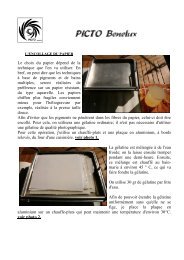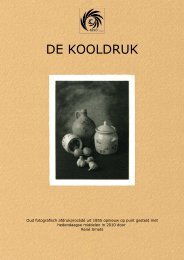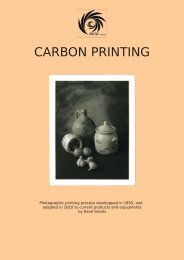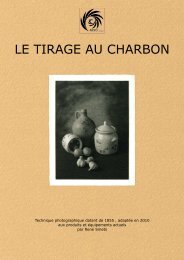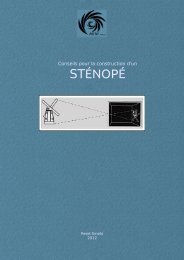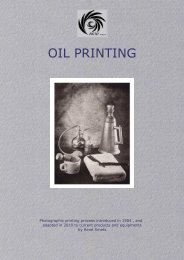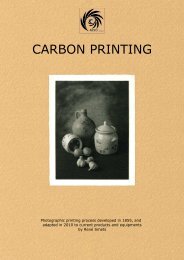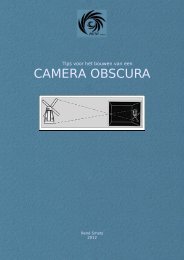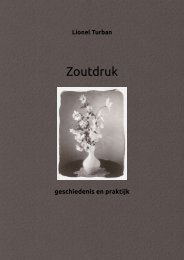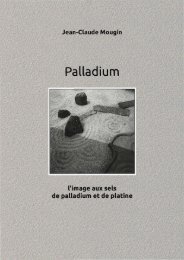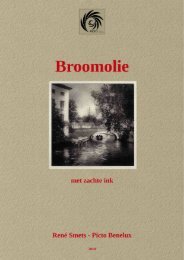Jean-Claude Mougin (pdf) - Picto Benelux
Jean-Claude Mougin (pdf) - Picto Benelux
Jean-Claude Mougin (pdf) - Picto Benelux
You also want an ePaper? Increase the reach of your titles
YUMPU automatically turns print PDFs into web optimized ePapers that Google loves.
1. Historical Background<br />
1803. Wollaston discovers palladium.<br />
1886. Döbereiner realizes the reduction of platinum chloride by light.<br />
1831. The same chemist discovers the light sensitivity of ferric oxalate.<br />
1844. Robert Hunt, in his work " Researches on Light " reports on his experiments<br />
with platinum.<br />
Hunt covered a sheet of paper with a mixture of ferric oxalate and platinum<br />
chloride which were darkening when exposed to light. But he was not able<br />
to discover the principle of its processing for permanency.<br />
1873. William Willis, son of a famous English engraver, works out the process.<br />
Three patents for a platinotype process were successively granted to him:<br />
British Patents of June 5th, 1873; August 20th, 1878 and August 15th, 1880.<br />
1880. Willis founded the Platinotype Company marketing his platinum paper in<br />
England. The Willis & Clements company from Philadelphia distributes it in<br />
the United States. From 1911 onwards, those two companies are selling up<br />
to 15 types of papers.<br />
1882. Giuseppe Pizzighelli and Arthur Baron Hübl, two Austrian Army officers,<br />
describe a manual method enabling photographers to prepare their own<br />
paper. Their dissertation incurred the wrath of the Platinotype Company<br />
which will try to disconsider their formulae. Il will be translated<br />
successively into English and French and even today, it is still considered<br />
a reference.<br />
1883. Creation of the Platino-Union in Austria. Platinum papers platinums are<br />
subsequently marketed by Ilford Company and Hesekiel in England, Gevaert<br />
in Belgium, Hesekiel Jacoby in Germany, American Aristotype Co., Ansco<br />
and Kodak in the United States.<br />
Nevertheless the platinotype wasn't quite successful in France where the<br />
photographers used to prefer the carbon, Artigue and Fresson processes.<br />
Famous photographers adopted the platinotype process, such as: Frederik<br />
Evans, Emerson, Stieglitz, Steichen, Coburn, Strand, Weston, Tina Modetti,<br />
and Manuel Álvarez-Bravo.<br />
1914. From this date, the platinum rates are skyrocketing, until reaching five<br />
times the value of gold, which results in a gradually decreasing demand for<br />
these papers.<br />
1916. The Platinotype Company introduces a cheaper palladium paper, the<br />
"palladiotype", as well as a silver-platinum based paper.<br />
1916. Kodak stops the manufacturing platinum paper.<br />
1937. No platinum paper is imported in the United States any more.<br />
1941. Production is stopped in Great Britain.<br />
1990. Creation of the Palladio Company in the United States, marketing a paper<br />
sensitized with platinum related metals.<br />
13



